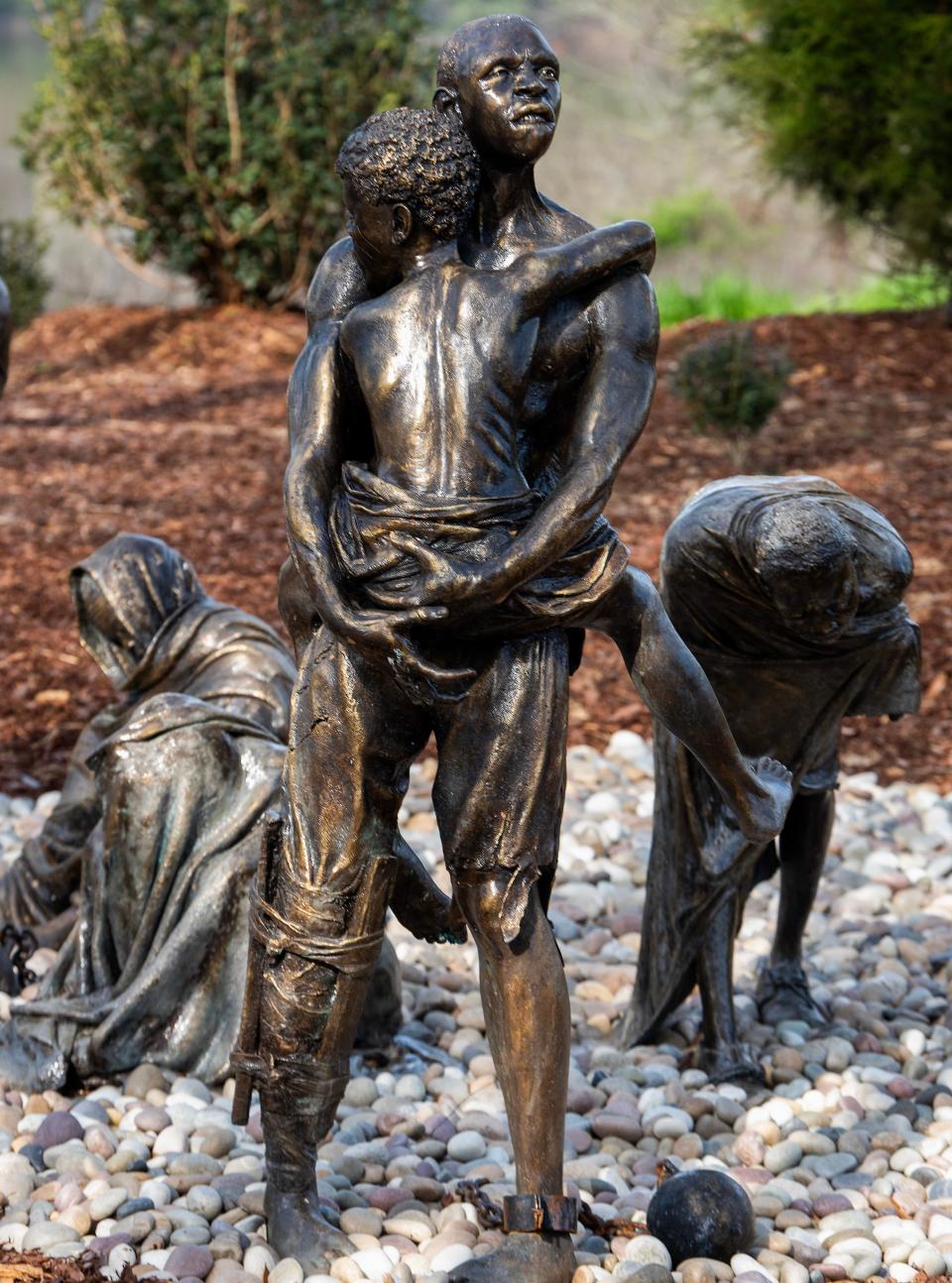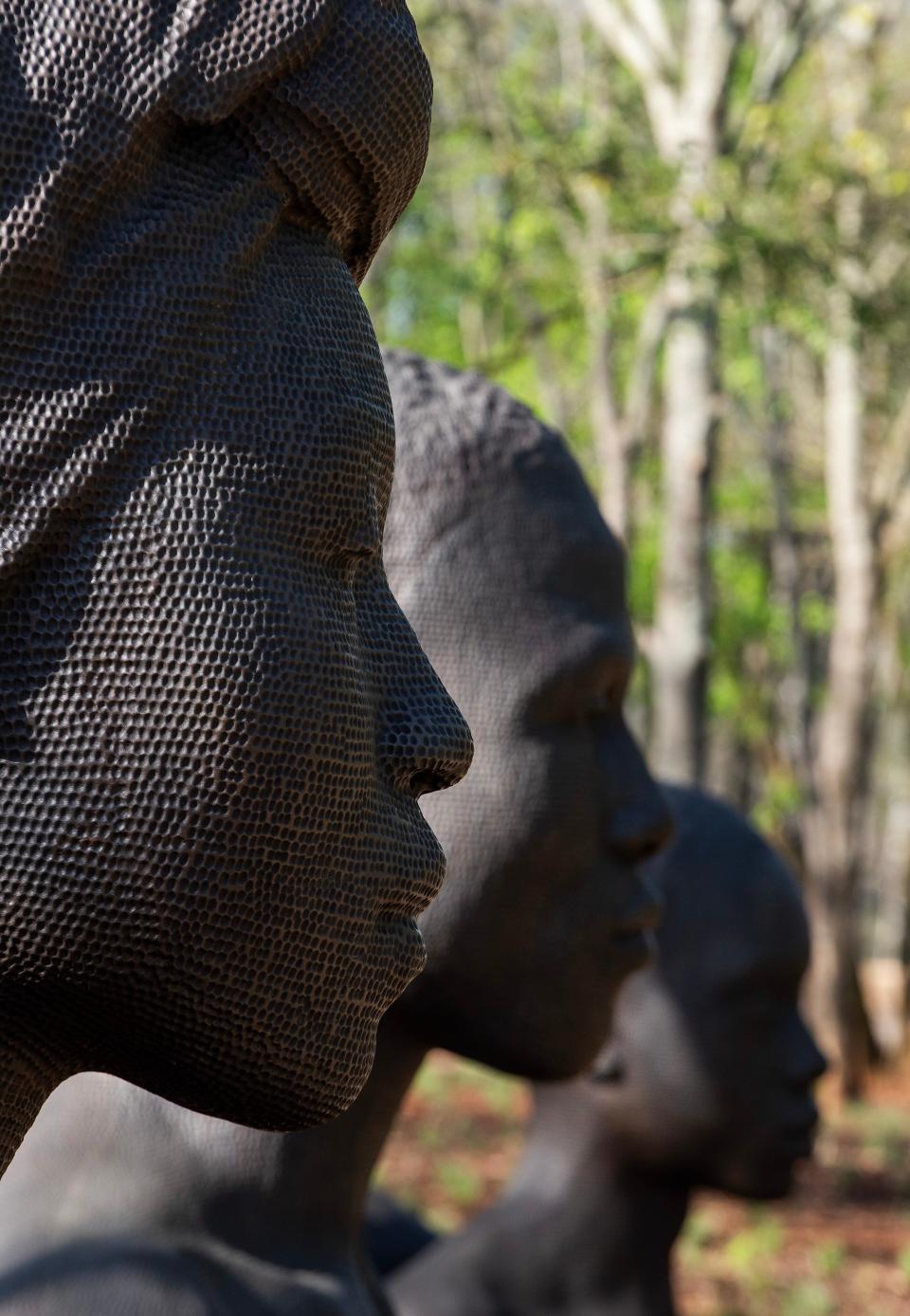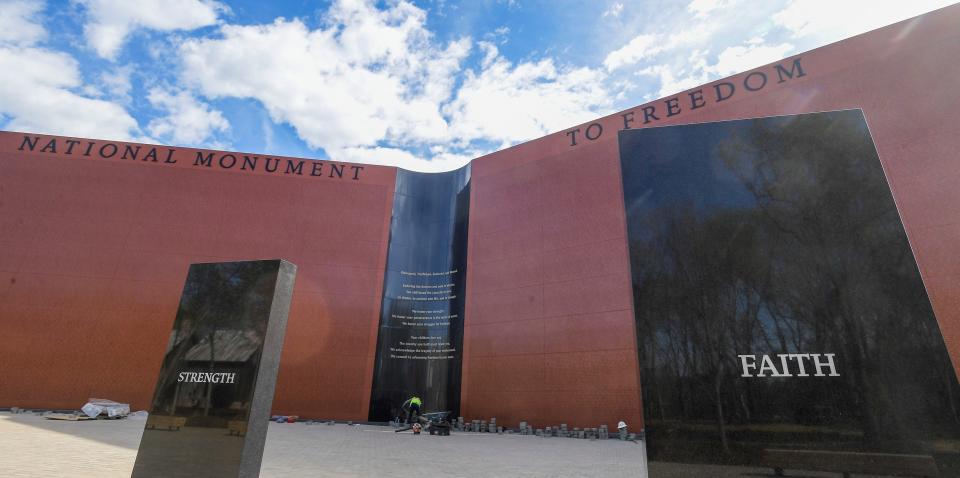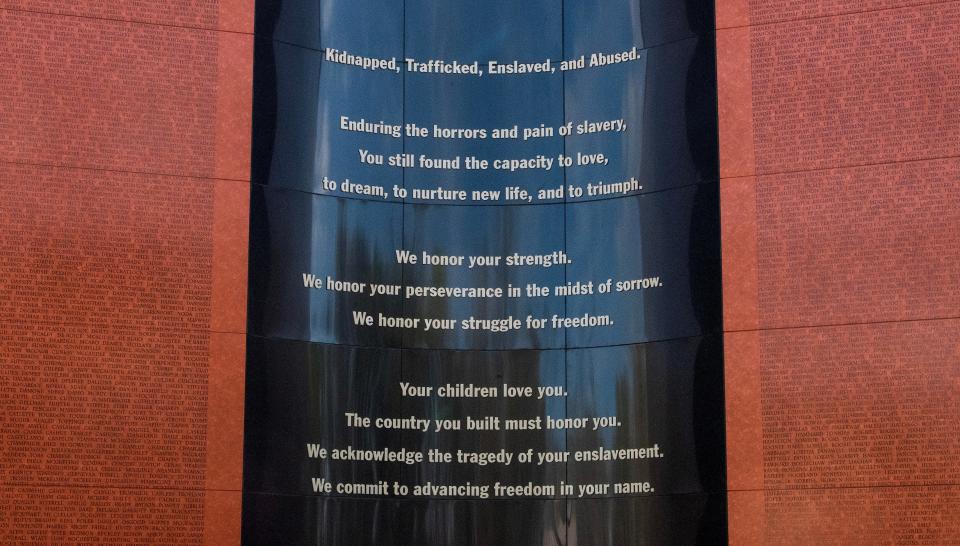'Never again': Equal Justice Initiative opens new park dedicated to history of slavery
- Oops!Something went wrong.Please try again later.
Nestled between the Alabama River and a set of Montgomery train tracks sits the Freedom Monument Sculpture Park — a new Equal Justice Initiative site where visitors can walk through the history of slavery in the United States.
From the start of the transatlantic slave trade to emancipation and the Reconstruction era, the 17-acre park emotionally encompasses it all through artwork, written stories, audio features and historic artifacts.
The nonprofit advocacy organization created the park as a companion to the National Memorial for Peace and Justice and the Legacy Museum, all working toward the goal of honoring the people who have advanced racial justice in America.
“We wanted to create a space that would center on the lives of enslaved people,” EJI founder and executive director Bryan Stevenson said. “There was a glaring need in this country to create a place where people could have an encounter with some of the architecture of that era.”
Along the path, visitors learn about the brutal manner in which kidnapped people from Africa were taken to America to be sold into slavery. There are representations of the boats that brought the African people, acknowledgements of the indigenous groups who were also enslaved and life-sized sculptures of people in chains, hunched over in despair, wearing heavy collars with spikes.

One group of sculptures includes several massive bronze busts of a woman, a man and three children, created by artist Rayvenn D. Clark and titled “Black Renaissance.”
“These sculptures are a ‘reconvening of history’ as they engage in the process of keeping the Black figures at the forefront of public consciousness,” Clark said in a statement on social media. "Thank you to EJI for trusting me with this important narrative."
A holding pen used to temporarily hold people until they were auctioned off stands along the trail, followed by a 24-foot by 30-foot railcar where slaves would be chained together and taken in groups of 20 or more. Nearby there are also three historic slave dwellings that have been relocated from plantations across the South.
“I don't think we've created enough spaces in this country that motivate people to say never again when it comes to racial bigotry, racial violence and racial injustice. Because we haven't made that commitment, we tolerate too much bigotry, violence and injustice,” Stevenson said. “My hope is that we can create an opportunity for people to be motivated when they leave to commit to ‘Never again.’”

The National Monument to Freedom
The park’s journey culminates at the foot of the 43-foot-tall National Monument to Freedom, which honors the more than 10 million Black people who were once enslaved in the U.S.
Across the monument is a long list of unique last names that Black people chose for themselves upon emancipation in 1865. Slavery as an institution stripped millions of individuals of identifiers that tied them to their ancestry and family, as surnames could change every time someone was sold to a different slave owner.
One individual documented in the park had at least three names before he was emancipated.
Thus, along with other freedoms gained with the end of slavery, Black Americans finally had the freedom to name themselves and their families.

EJI analyzed the 1870 census, among other data, to create a list of over 100,000 surnames of emancipated people. In the park’s visitors center, guests will be able to research their own names and see if they can trace their genealogy back to the 1870 census.
Stevenson himself was able to learn more about his father’s ancestry using the research, tracking ancestors back to specific parts of Virginia and Maryland.
“The country you built must honor you,” part of the monument’s inscription reads. “We acknowledge the tragedy of your enslavement. We commit to advancing freedom in your name.’’
Visitors can also use a QR code to access a website that will walk them through how to find a specific name on the monument. The site will tell the user where to stand and which line to look at on the monument.
“Montgomery, steeped in history, offers an authentic, purposeful tourism experience. EJI’s sculpture park has built upon their existing work, delving into the legacy of slavery and the lives of those who were enslaved," Montgomery Chamber chief destination officer Ron Simmons said. "EJI’s new National Monument to Freedom is a powerful, thought-provoking, and profoundly moving encounter. We are fortunate that Bryan Stevenson chose Montgomery to unite people and share this important narrative.”

Opening day and ticket prices
Since EJI first announced the new site in the fall of 2023, the organization has been committed to a spring 2024 opening day. While the park is not yet entirely complete, EJI is holding true to that promise.
From March 27 onward, tourists will be able to enter the sculpture park and view the National Monument to Freedom. One $5 ticket provides all access to the sculpture park, Legacy Museum and the National Memorial for Peace and Justice.
“We don’t want anyone to not come because they can’t afford it,” Stevenson said.
He added that the park will be closed for a few weeks in April while 11 more sculptures will be installed. EJI had not yet announced those specific dates.

How to get there
While the museum and memorial sites are relatively central to downtown Montgomery, the Freedom Monument Sculpture Park is a little off the beaten path. Located at 831 Walker St., it is about a mile north of the museum.
EJI will offer shuttles to and from the location, but visitors can also drive themselves. Trains often block the most direct route to the park from downtown, so guests may want to take I-65N toward Birmingham and exit at North Boulevard to make their way there.
Come this summer, there will also be an option to take a boat from downtown up the river to the park. This will allow visitors to enter the site via the same waterway where many enslaved people entered Montgomery.
Hadley Hitson covers children's health, education and welfare for the Montgomery Advertiser. She can be reached at hhitson@gannett.com. To support her work, subscribe to the Advertiser.
This article originally appeared on Montgomery Advertiser: Inside EJI's new sculpture park: Featured art, ticket prices and more

